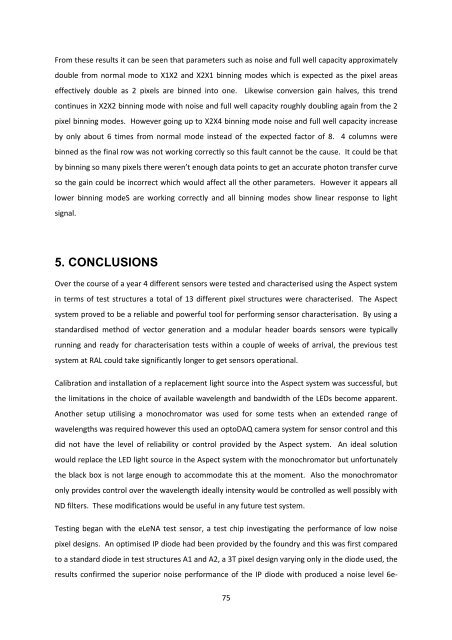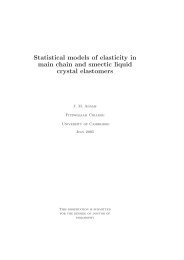Dissertation - FTP Directory Listing - University of Surrey
Dissertation - FTP Directory Listing - University of Surrey
Dissertation - FTP Directory Listing - University of Surrey
You also want an ePaper? Increase the reach of your titles
YUMPU automatically turns print PDFs into web optimized ePapers that Google loves.
From these results it can be seen that parameters such as noise and full well capacity approximatelydouble from normal mode to X1X2 and X2X1 binning modes which is expected as the pixel areaseffectively double as 2 pixels are binned into one. Likewise conversion gain halves, this trendcontinues in X2X2 binning mode with noise and full well capacity roughly doubling again from the 2pixel binning modes. However going up to X2X4 binning mode noise and full well capacity increaseby only about 6 times from normal mode instead <strong>of</strong> the expected factor <strong>of</strong> 8. 4 columns werebinned as the final row was not working correctly so this fault cannot be the cause. It could be thatby binning so many pixels there weren’t enough data points to get an accurate photon transfer curveso the gain could be incorrect which would affect all the other parameters. However it appears alllower binning modeS are working correctly and all binning modes show linear response to lightsignal.5. CONCLUSIONSOver the course <strong>of</strong> a year 4 different sensors were tested and characterised using the Aspect systemin terms <strong>of</strong> test structures a total <strong>of</strong> 13 different pixel structures were characterised. The Aspectsystem proved to be a reliable and powerful tool for performing sensor characterisation. By using astandardised method <strong>of</strong> vector generation and a modular header boards sensors were typicallyrunning and ready for characterisation tests within a couple <strong>of</strong> weeks <strong>of</strong> arrival, the previous testsystem at RAL could take significantly longer to get sensors operational.Calibration and installation <strong>of</strong> a replacement light source into the Aspect system was successful, butthe limitations in the choice <strong>of</strong> available wavelength and bandwidth <strong>of</strong> the LEDs become apparent.Another setup utilising a monochromator was used for some tests when an extended range <strong>of</strong>wavelengths was required however this used an optoDAQ camera system for sensor control and thisdid not have the level <strong>of</strong> reliability or control provided by the Aspect system. An ideal solutionwould replace the LED light source in the Aspect system with the monochromator but unfortunatelythe black box is not large enough to accommodate this at the moment. Also the monochromatoronly provides control over the wavelength ideally intensity would be controlled as well possibly withND filters. These modifications would be useful in any future test system.Testing began with the eLeNA test sensor, a test chip investigating the performance <strong>of</strong> low noisepixel designs. An optimised IP diode had been provided by the foundry and this was first comparedto a standard diode in test structures A1 and A2, a 3T pixel design varying only in the diode used, theresults confirmed the superior noise performance <strong>of</strong> the IP diode with produced a noise level 6e-75
















